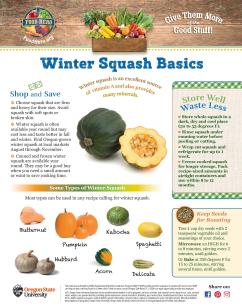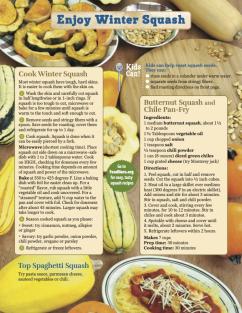Winter Squash Basics
Winter squash is an excellent source of vitamin A and also provides many minerals.
Shop and Save
- Choose squash that are firm and heavy for their size. Avoid squash with soft spots or broken skin.
- Winter squash is often available year round but may cost less and taste better in fall and winter. Find Oregon-grown winter squash at local markets August through November.
- Canned and frozen winter squash are available year round. They may be a good buy when you need a small amount or want to save cooking time.
Some Types of Winter Squash
Most types can be used in any recipe calling for winter squash.
- Butternut
- Pumpkin
- Kabocha
- Spaghetti
- Hubbard
- Acorn
- Delicata
Store Well Waste Less
- Store whole squash in a dark, dry, and cool place (50 to 55 degrees F).
- Rinse squash under running water before peeling or cutting.
- Wrap cut squash and refrigerate for up to 1 week.
- Freeze cooked squash for longer storage. Pack recipe-sized amounts in airtight containers and use within 8 to 12 months.
Keep Seeds for Roasting
Toss 1 cup dry seeds with 2 teaspoons vegetable oil and seasonings of your choice.
Microwave on HIGH for 6 to 8 minutes, stirring every 2 minutes, until golden.
Or Bake at 350 degrees F for 15 to 25 minutes, stirring several times, until golden.
Enjoy Winter Squash
Recipes
Cook Winter Squash
Butternut Squash and Chile Pan-Fry
Kids Can!
Kids can help roast squash seeds. They can:
- rinse seeds in a colander under warm water.
- separate seeds from stringy fibers.
- find roasting directions on front page.
Top Spaghetti Squash
Try pasta sauce, parmesan cheese, sautéed vegetables, or chili.




